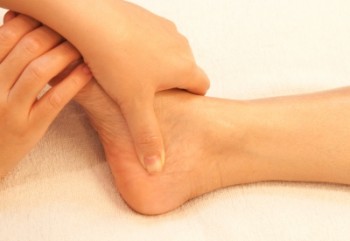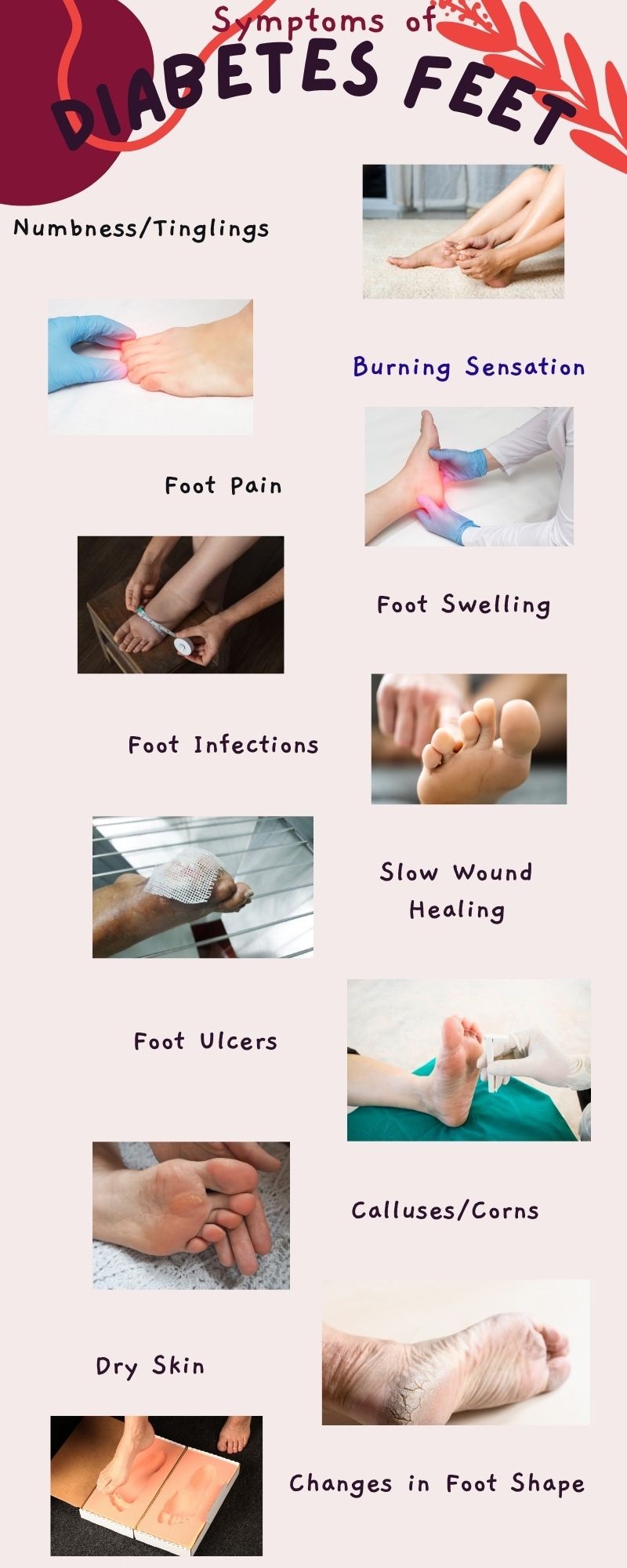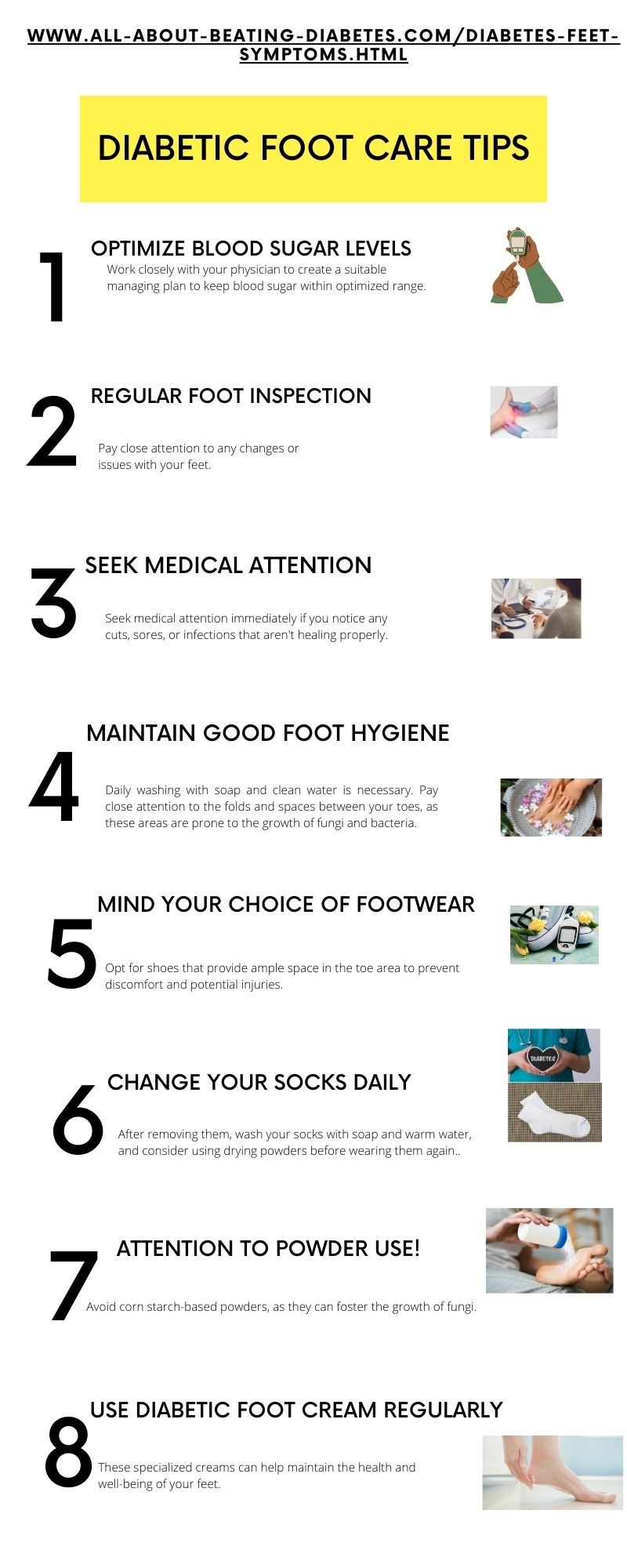- Home
- Complications
- Diabetes feet symptoms
Recognizing the Diabetes feet symptoms
What happens to your feet during diabetes?
Having diabetes can result in enduring high sugar levels for over two decades, leading to the impairment of blood vessels in your feet, rendering them more susceptible to additional damage.
Additionally, the nerves in your feet may also be affected, causing a loss of sensitivity to pain.
Diabetes can have profound consequences for the feet, particularly when persistently high sugar levels persist for over two decades.
Even seemingly minor injuries and conditions like cuts, calluses, ingrown toenails, bunions, athlete's foot, and corns can transform into neuropathic ulcers due to impaired blood vessels and damaged nerves.
Neglecting appropriate care for these ulcers can lead to a dire outcome: the development of gangrene, the most dangerous complication among all foot symptoms.
Tragically, gangrene is an incurable condition, leaving amputation of the affected foot or even the entire leg as the only viable solution.
Given the gravity of the situation, it becomes paramount to prioritize the care of diabetes-related foot symptoms.
By diligently managing blood sugar levels and adopting proper foot care practices, individuals can substantially reduce the risk of such complications.
Regular inspection of the feet for any signs of injury or infection, wearing comfortable and appropriate footwear, keeping the feet clean and moisturized, and seeking prompt medical attention for any foot issues are vital steps in maintaining foot health.
Empowering oneself with knowledge about diabetes foot care and collaborating closely with healthcare professionals can be the keys to preserving the health and function of the feet, thus preventing the potentially devastating consequences that poorly managed diabetes can bring.
What are diabetes-related symptoms?
Diabetes can lead to a range of foot symptoms and complications due to its impact on nerves, blood vessels, and the immune system. These symptoms may vary depending on the individual and the stage of diabetes. Here are some common diabetes-related foot symptoms:
1. Numbness or tingling: High blood sugar levels can damage nerves, leading to a condition called diabetic neuropathy. This may cause a loss of sensation or tingling sensations in the feet.
2. Burning sensation: Some individuals with diabetic neuropathy may experience a burning sensation in their feet, which can be uncomfortable and painful.
3. Foot pain: Diabetic individuals may experience pain in their feet, either due to nerve damage or poor blood circulation.
4. Swelling: Poor circulation and kidney problems associated with diabetes can lead to fluid retention and swelling in the feet and ankles.
5. Infections: Diabetes can weaken the immune system, making individuals more susceptible to infections. Cuts, blisters, or wounds on the feet can become infected and lead to serious complications.
6. Slow wound healing: High blood sugar levels can impair the body's ability to heal wounds, making it challenging for cuts, sores, or ulcers on the feet to heal properly.
7. Foot ulcers: Reduced sensation and poor blood flow can lead to the development of foot ulcers, which are open sores on the feet that can be challenging to treat.
8. Calluses and corns: Diabetes can cause thickened areas of skin on the feet, particularly in areas subject to pressure or friction, such as the heels or the balls of the feet.
9. Dry skin: Diabetes can lead to reduced oil production in the skin, resulting in dry and cracked skin on the feet.
10. Fungal infections: Diabetics are more susceptible to fungal infections, such as athlete's foot, which can cause itching, redness, and cracked skin between the toes.
11. Changes in foot shape: Long-standing uncontrolled diabetes can lead to foot deformities, such as Charcot foot, where the bones weaken and collapse.
Tips about Diabetic Feet Care
Proper care for diabetic feet is crucial to prevent infections and maintain overall foot health.
Here are some essential tips you should follow:
1. The foundation of diabetic foot care is to maintain optimized blood sugar levels. Work closely with your physician to create a suitable meal plan and incorporate additional meals as recommended.
Smoking cessation is of the utmost importance. Smoking significantly increases the risk of blood circulation problems, which can be detrimental to diabetic feet.
Quitting smoking can have a positive impact on your foot health and overall well-being.
Regular physical activity is essential for managing diabetes. Incorporate aerobic exercises into your routine, or aim for at least 15 minutes of walking daily.
Following your physician's guidance, engage in exercises that suit your health condition.
2. Moreover, pay close attention to any changes or issues with your feet. Conduct regular foot inspections to detect any signs of injury, infection, or abnormalities.
Properly clean and moisturize your feet, and choose comfortable footwear that fits well and provides adequate support.
Proper foot care is essential to maintaining healthy and happy feet. In addition to the above-mentioned considerations, regular foot examination is crucial. Utilizing a mirror can aid in a thorough inspection of your feet, ensuring any potential issues are detected early.
3. It is essential to promptly address any foot problems or concerns. Seek medical attention immediately if you notice any cuts, sores, or infections that aren't healing properly.
4. Maintaining good foot hygiene is paramount. Daily washing with soap and clean water is necessary. Pay close attention to the folds and spaces between your toes, as these areas are prone to the growth of fungi and bacteria.
5. Be mindful of your choice of footwear. Opt for shoes that provide ample space in the toe area to prevent discomfort and potential injuries. Avoid ill-fitting shoes that may cause irritation or pain.
Orthopaedic shoes, particularly those designed for diabetics, can be highly beneficial. These shoes not only allow your feet to breathe properly but also provide additional protection for sensitive diabetic feet.
Steer clear of shoes made from synthetic materials and those with high heels, as they can compromise stability, security, and comfort for your feet.
6. Changing your socks daily, or even twice a day if your feet tend to sweat profusely, is crucial. After removing them, wash your socks with soap and warm water, and consider using drying powders before wearing them again.
7. Pay attention to the type of powder you use. Avoid corn starch-based powders, as they can foster the growth of fungi. Instead, opt for moisture-wicking materials like cotton socks to keep your feet dry and healthy.
8. In addition to the aforementioned tips, consider incorporating diabetic foot creams into your foot care routine. These specialized creams can help maintain the health and well-being of your feet.
By diligently following these diabetic foot care tips and collaborating with your healthcare team, you can significantly reduce the risk of foot complications and maintain healthy feet, ultimately enhancing your quality of life and overall health.
Remember, your feet play a significant role in your daily life, carrying you through each step.
Neglecting foot care can lead to discomfort, pain, and potentially serious medical conditions. By following these simple guidelines and making foot care a priority, you can enjoy the benefits of healthy and happy feet for years to come.
|
Written by Dr.Albana Greca Sejdini, Md, MMedSc Medically reviewed by Dr.Ruden Cakoni, MD, Endocrinologist |
Last reviewed 07/19/2023 |
References:
References:
- American Podiatric Medical Association (APMA): The APMA website provides valuable information on foot health, foot care tips, and recommendations for selecting appropriate footwear. Website: https://www.apma.org/
- Centers for Disease Control and Prevention (CDC): The CDC offers guidelines on foot care for people with diabetes and other foot-related health issues. Website:
- Mayo Clinic: Mayo Clinic's website has a section dedicated to foot care, including tips on maintaining foot health and preventing foot problems. Website:
- National Institute of Diabetes and Digestive and Kidney Diseases (NIDDK): The NIDDK provides resources on diabetic foot care and its importance in managing diabetes. Website: https://www.niddk.nih.gov/health-information/diabetes/overview/preventing-problems/foot-problems
- WebMD: WebMD's foot care section covers various topics related to foot health, foot conditions, and preventive measures. Website: https://www.webmd.com/diabetes/foot-care#1
Diabetes complications Questions or Problems? Get Help Here
This is the place where you can ask a question about any aspect of diabetes complications.
It's free and it's easy to do. Just fill in the form below, then click on "Submit Your Question".


